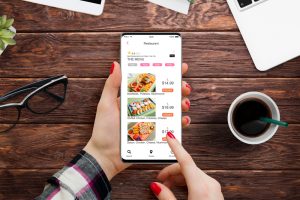Food delivery has become a hotspot in the business world because of the lucrative profits it brings. There is no doubt that the Covid-19 pandemic has contributed a lot to its growth in the last two years. Also, the idea of relishing piping hot restaurant food in the comfort of your home has undeniably brought a craze about food delivery apps like Zomato.
As per Statista’s report, the revenue in the online food delivery market is projected to reach US$0.91tn in 2023. And the most astonishing part about this figure is that it is just the market share of “food delivery” of the entire industry. So, it’s not hard to imagine the total yield from the food & dining industry as a whole.
Coming to Zomato, it is undoubtedly the most widely used food delivery app in India at present followed by Swiggy. The Indian Subsidiary of Uber Eats i.e. Uber Eats India, was acquired by Zomato in January 2020. So, if you’re running a food business and are thinking of getting an online delivery app, Zomato is the ideal app to set as an example.
Table Of Contents:

Importance of Food Delivery Apps in Today’s Time
The reason behind the fuelling rise in food delivery apps is the emergence of smartphones along with high-speed internet. With the increase in population, the demands and expectations of the people, especially the working youth, have also grown. And with food delivery apps, they have the comfort of ordering food online and getting it delivered to their doorstep in between their busy work schedules.
Besides, when giant players in the food industry like KFC, Dominos, and McDonalds, started contactless deliveries, it became an inspiration for startups and other food business houses to have their own online apps.
Altogether, the food ecosystem got a boost when online ordering through apps came into the scenario. In short, “Now” is the right time to get started with your Zomato-like app. You can connect with the best food delivery app development company to get it done successfully.
Before we dig deeper into the process of building a food app, let’s check its significance in business in brief.

It helps in building brand awareness – The usage of apps in recent years has increased a lot with the introduction of smartphones. Hence, presenting your customers with a medium through which they can communicate and use your services directly from anywhere is an incredible idea. It also promotes your brand and increases your customer reach.
Drive sales – Sometimes despite having a fondness for a particular restaurant, customers are not able to visit due to tight work schedules. In such instances, if you provide them with the luxury of ordering their favorite dish from their favorite restaurant, your sales will grow. And customers will be happy too!
Retarget old customers – Undoubtedly, food is for survival but tasty food is all about sentiments. Also, with the help of apps, you can tempt your existing customers with attractive deals, stunning visuals, and other creative ideas. This way you can drive more revenue from repeat business.
Targeted Marketing Campaign – Running offline campaigns for specific demographics and individuals is impossible because of money and time constraints. However, with mobile apps, you can pursue personalized and targeted marketing and entice a particular customer or section of people for sales.
Business Model of the Leading Food Delivery App Zomato Explained
Zomato follows a typical “on-demand” approach by acting as a connecting medium for customers, restaurants, and delivery team. Consumers order food on the Zomato platform which is then processed and forwarded to the selected restaurant. Zomato also assigns a delivery person who then reaches the restaurant to pick up your meal and bring to it you.
Apart from providing online food delivery services, Zomato has two other offerings. These two are online table reservations and Zomato Gold (premium membership that provide attractive deals on restaurants and dine-ins).
The business model of Zomato and any other food delivery service app basically has three core components.
User: Users are the customers who open the app and browse through restaurants and takeaways that have registered themselves in Zomato. The user selects a restaurant and decides the items and quantity to order. After placing the order, the user waits for the restaurant to accept his or her order.
Admin: The moment an order is placed on Zomato, three entities get notified – the admin, the chosen restaurant, and the delivery person available nearby. If anything goes wrong with the order, suppose an issue with payment, wrong items delivered, or delay in delivery, it is the admin that coordinates with the customer, delivery person, and the restaurant to get it resolved.
Delivery Person: The delivery guy, upon receiving the notification, reaches the restaurant and waits for the meal during preparation. Once the order is ready, the delivery person picks it up and travels to the delivery point i.e the user.
So, it can be concluded that there are 3 key stakeholders in a food delivery app – Admin, User, and Delivery Executive.
Read Also: How to Build an App Like Uber?
Key Features and Functionalities of the Three Modules
Before thinking about how to design a food delivery app, you must acquire knowledge about its 3 facets.
Admin Module
Brand owner, Zomato, in this case, develops the app following the admin module. As an admin, it acts as the chief connecting platform among the customer, restaurant, and delivery person. Admin is also responsible for maintaining a dashboard to supervise and manage the online food delivery business as a whole.
The core features to be included in the Admin module are:
- Live Tracking – The owner of the app must be able to track as well as monitor the entire process in real-time – from placing the order to final delivery. He should be connected to customers, restaurants, and delivery persons all the time. This live tracking feature helps the owner to monitor the delivery fleet and check whether the delivery is processed on time.
- App Analytics – App analytics will give insights into the total number of orders, customer locations, restaurant locations, order segmentation, and other such business analytics data that are helpful in predicting customer trends. The app analytics are used for making data-driven and informed decisions.
- Admin Dashboard – The app owner needs a dashboard to manage the core functions of his online food delivery business. This function basically includes checking order status, driver location, delivery points, checking restaurant profiles, managing marketing, and so on.
User Module
The user is the most fundamental part of the online food ordering app and therefore, the UI and UX should be top-notch to ensure that users have a smooth ordering experience. The user module needs a lot of integrations and rich functionalities which are discussed below.
The core features to be included in the user module are:
- Restaurant browsing: The search option is the first and foremost requirement in the customer-specific module of the app. Every foodie, through your app, should be able to check an array of restaurants on various locations and their menus and then decide on one.
- Contact restaurant: You must give the user the facility to call the restaurant directly for any kind of order-related queries, order confirmations, and order modifications. Zomato even lets the users add cooking instructions and cutlery requirements to the chosen restaurant.
- Contact Delivery Person: The user needs to call the delivery person to give the route information and know the time of his arrival at the location. Users can also add delivery instructions to make the job of delivery guys easy.
- Social media integration: Users should have the facility to create their accounts on your seamlessly through their social media profiles.
- Various Payment Modes: No user would use your food app unless you offer them multiple payment options such as cash, credit & debit card, UPI wallets, and mobile banking. Thus, diverse payment integrations in your app is necessary to ensure customer satisfaction.
- Real-time alerts and notifications: Besides tracking their order live on the app, users should get notified about their order and payment status via emails, in-app notifications, and sms.
- Rating and feedback: Customer ratings and reviews play an integral part in the food delivery chain. It helps them to improve their service quality and also receive appreciation when customers are satisfied. Thus, your app should allow the customers to share and rate their experience with the delivery guy, restaurant service, and food quality.
- Order Tracking: The customer should have the benefit to track his order when prepared at the restaurant, and picked up by the delivery boy. Through live tracking, the user follows the driver’s journey to his location and can also guide him in finding the shortest route.
- Personalized offers: In on-demand apps, users’ needs are the first priority. Your food delivery app is no exception to this. Your app must have a separate feature where it highlights all the latest deals, festival offerings, loyalty rewards, coupon discounts, and a lot more. This will also help in customer retention.
Therefore, the restaurant app development company you hire to build your app should focus on integrating these must-have features into your app.
Delivery Module:
The delivery module is designed and developed to cater to all the requirements of the delivery team. The essential features that need to be integrated into the delivery module of your food online business are discussed below.
- Navigation: The navigation function helps users and drivers to track orders, access restaurant information, and find the best routes to reach the restaurant and customer.
- Contact Information: It is the delivery team of the Zomato business model that takes the responsibility of sharing restaurant and driver contact details with the user.
- Trip logs: The delivery team also ensure timely delivery of food orders to the customers by checking trip log time, validating deliveries, and monitoring drivers’ performances.
- Route optimization: The app also has a route optimization feature that helps the delivery rider find the shortest route and avoid traffic.
- Trip information: The delivery person with the help of this feature logs the time of his trip start and end.
Apart from all these above-mentioned features, your Zomato-like food delivery app should also offer some other functionalities to make the user experience friendly and pleasant. These include
- Chatbot or customer support
- Tracking order history
- Check transaction history
- Submit restaurant reviews
- Map views
- Upload images
- Order for someone else and send e-card
Read Also: How To Develop a Voice Assistance Application Like Alexa?
Quick Tips To Keep in Mind While Building an App like Zomato
When you approach a mobile app development company for your food delivery make sure you specify your business goal clearly and put forward your exact requirements. The key points that an app developer needs to focus on are
- Easy navigation for the users
- User-friendly interface
- Regular updates from restaurants
- 24*7 customer service
- Easy to manage profiles for the users
Final Words
The food delivery industry is thriving and is projected to have a market volume of US$450.30 billion by 2027. With such astounding numbers, it’s really hard to ignore the hype around food delivery app development.
Hence, if you’re one of those who are eager to create an app but wondering how to create a food delivery app, then we’re here to guide you. Our mobile app developers have the right kind of expertise to build apps with excellent features.








